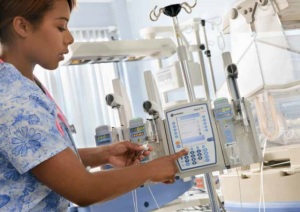by
Lauren Dubinsky, Senior Reporter | May 29, 2014

CareFusion’s Alaris System
From the May 2014 issue of HealthCare Business News magazine
Today, health reform is affecting every aspect of the patient care, leading many hospitals to adopt technology, like infusion pumps, to help meet new regulatory requirements.
The U.S. infusion pump market is expected to grow from $2.7 billion in 2012 to $3.6 billion in 2017, according to a Millennium Research Group (MRG) report. Experts say the growth is being fueled by a combination of the interest in pump designs for pain management and pumps with smart capabilities that can be integrated into the electronic medical record.
Such pumps help hospitals to meet requirements for government payment incentives and to avoid penalties. But hospitals aren’t the only ones benefitting. Pain management pumps help to make the patient more comfortable and smart pumps integrated into the EMR can help to prevent fatal medication errors — all for the benefit of the patient.
Get incentives, avoid penalties
“Hospital quality ratings and how hospitals manage patients’ pain is everything,” says James Laskaris, senior analyst at MD Buyline. It’s everything because it affects how much hospitals will get paid.
The Centers for Medicare and Medicaid partnered with the Agency for Healthcare Research and Quality, an agency in the Department of Health and Human Services, to create the Hospital Consumer Assessment of Healthcare Providers Systems (HCAHPS) survey.
The survey is a standardized survey that patients fill out in order to measure their perspectives on hospital care. Hospitals can qualify for bonus payments from CMS depending on the feedback patients give in the survey.
A big part of the survey involves how well the hospital managed a patient’s pain.
“That’s the question that’s going to be on every survey and you want a five on there,” says Brandi Crow, clinical analyst at MD Buyline.
One way hospitals are trying to boost that score is to purchase infusion pumps specifically designed for pain management, which is typically divided into three different pump categories: disposable postoperative pain management pumps, hospital electronic ambulatory pumps and high-end pain management syringe pumps.
I-Flow, Baxter and Moog make pumps for the disposable ambulatory pump market, and Hospira and Smiths Medical manufacture both electronic ambulatory and syringe pumps. (Moog is also a part of the electronic ambulatory pump market and CareFusion is a part of the syringe pump market.)
Pumps can also help hospitals avoid costly penalties. The Hospital Readmission Reduction Program, which began on October 1, 2012 under the health care reform law, gives CMS the authority to reduce payments to inpatient prospective payment systems hospitals with excessive readmissions.
